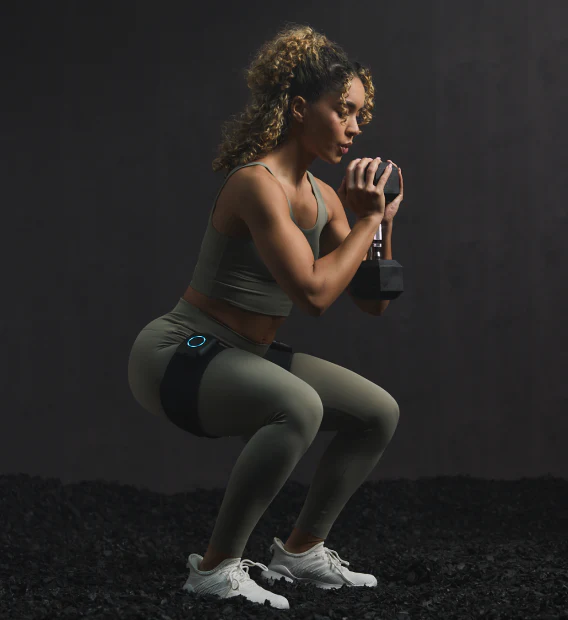A Joint-Friendly Shortcut to Strength (Even if You Have Nagging Injuries)
You’ve done your share of heavy squats and lung-burning HIIT classes; now the knees are filing formal complaints. 😖🦵🏽
Enter blood-flow restriction (BFR) training: a method that lets you coax muscle fibers into growth with weights so light they feel like props.
Why it plays so nicely with over-40 bodies
- Joint kindness – Lifting at just twenty-to-thirty percent of your usual 1-rep max spares cartilage and cranky tendons.
- Muscle-fiber rescue – Estrogen’s slow fade can speed up sarcopenia--the dreaded age-related reduction in lean body mass (a.k.a. muscle) and your toned body starts to get weak and flabby. BFR flips that script, boosting type-II fiber size even with light-weight loads.
- Cardio perks – Light-load BFR can nudge blood-vessel function in the right direction, a bonus if heavy squats spike your blood pressure.
- Time efficiency – Typical BFR sets are quick: thirty reps to start, rest, then three more fifteen-rep bursts. Ten minutes and done.
How BFR Works
To restrict blood flood, you’ll wrap a pair of snug cuffs (think high-tech tourniquets, not medieval torture devices) at the top of your arms or legs.
They let arterial blood in but slow the ride back out. The trapped blood creates a mini “traffic jam” that tricks muscle fibers into thinking you’re lifting heavy—even when you’re only curling five-pound dumbbells.
Metabolic stress shoots up, growth hormone gets jump-started, and muscles grow without the usual wear-and-tear.
For women 40+ juggling hormonal shifts, joint niggles, or plain old time crunches, that’s a sweet deal.
Recent reviews on middle-aged and older women show solid gains in strength and a helpful dip in resting blood pressure after as little as eight weeks of low-load BFR work.
The safety checklist ✅
Before you grab a set of cuffs, tick these boxes:
- Get cleared if you have uncontrolled hypertension, clotting disorders, peripheral vascular disease, diabetes with neuropathy, or you’re post-surgery on a vascular graft.
- Pick the right gear. Look for medical-grade inflatable cuffs, four-to-seven inches wide, with a handheld pump or Bluetooth app that shows pressure. Skip skinny elastic bands you found in the discount bin; uneven pressure is an invitation for blood clots like Deep Vein Thrombosis (DVT). I recommend SAGA BFR cuffs, since they allow you to precisely measure the amount of pressure and keep track of your training.
- Pressure matters. Use limb-occlusion pressure (LOP) testing if your cuff allows. Then work at about 40%-50% of that number for legs (30%-40% for arms). Translation: snug but still able to slide two fingers under the cuff.
- Listen to your body. Numbness, pins-and-needles, or skin color turning Smurf-blue? Release immediately.
Building a Lower-Body BFR Session
BFR sessions pivot around the classic 30-15-15-15 rep pattern: 30 reps, quick breather, then 3 rounds of 15. Cuffs stay inflated the whole time and come off after about five minutes of work. Below are two detailed road maps—one to fire up the glutes, another to set quads ablaze—so you can pick the emphasis your program needs.
Glute-Focused Protocol
- Warm-up (5 min) – Easy treadmill walk or stair stepper with cuffs loose.
- Cuff inflate – Position cuffs high on the thighs; pump to working pressure.
- Hip Thrusts (30 reps) – Body-weight or mini-band, focusing on a one-second squeeze at lockout.
- Rest 30 s (cuffs stay on).
- Dumbbell Romanian Deadlifts (15 reps) – Light weights, three-second lowering phase to stretch hamstrings and glutes.
- Rest 30 s.
- Frog Pumps or Glute Bridges (15 reps) – Knees flared, heels together to keep tension smack on the glute max.
- Rest 30 s.
- Cable or Band Kick-Backs (15 reps each side) – Drive the foot straight back, focus on full hip extension.
- Deflate cuffs – Walk for a minute, stretch hip flexors.
Expect your backside to feel like you just PR’d a deadlift, minus the next-day low-back grumbles.
Quad-Focused Protocol
- Warm-up (5 min) – Stationary bike spin with cuffs loose.
- Cuff inflate – Same placement, same pressure guidelines.
- Box-Depth Body-Weight Squats (30 reps) – Tap a box each time to ensure consistent depth.
- Rest 30 s.
- Goblet Squats (15 reps) – Light kettlebell, torso upright to bias quads.
- Rest 30 s.
- Walking Lunges (15 steps per leg) – Body-weight or baby dumbbells; keep stride moderate, knee tracking over toes.
- Rest 30 s.
- Wall-Sit Hold (45 s) or Leg Extensions (15 reps) – Either choice will make quads hum like a tuning fork.
- Deflate cuffs – Shake out, then stretch quads and hip flexors.
Both sessions keep total cuff time under six minutes, which research flags as the sweet spot for maximizing muscle fiber recruitment while minimizing vascular risk.
Programming Tips
- Frequency – Two or three BFR workouts a week, alternating glute- and quad-focus, or tack one onto the end of a heavier day as a burn-out finisher.
- Progression – Add a couple of pounds to your light loads, edge cuff pressure up five percent (within safe range), or extend each hold by ten seconds every second week.
- Recovery – Delayed-onset soreness is milder than with heavy lifting, but give a 48-hour buffer before cuffing the same limb again.
The Bottom Line…
BFR offers a science-backed shortcut for women over forty who want to reclaim power without bullying their joints. Respect the pressure guidelines, steer clear if you sit in the DVT-risk column, and rotate glute- and quad-centric sessions for a balanced lower half. Follow those rules and you’ll step out of the gym stronger, not sorer—and your knees might even send a thank-you note.
